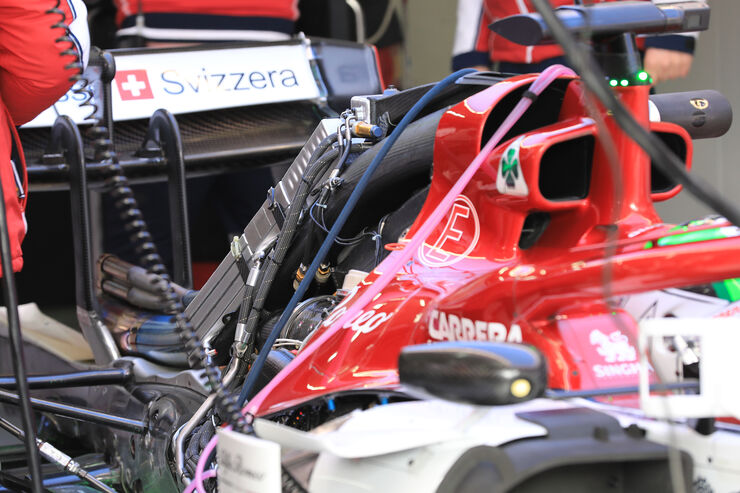Yes. I have seen that before.
But what i am saying is steel is stronger for this so it is another advantage.

Yes. I have seen that before.
It's strength at high temperature is a lot higher than aluminium too so I'd think if you were suffering thermal deg on the crowns, it'd be even worse with ally ones anyway.PlatinumZealot wrote: ↑18 Feb 2019, 03:35
Yes. I have seen that before.
But what i am saying is steel is stronger for this so it is another advantage.
I think if we still only needed 2 races per engine, it would be aluminum for sure.ringo wrote: ↑18 Feb 2019, 06:29With lean burn combustion i don't think the temperatures are widespread to the walls and pitons of the cylinders.
Less heat is rejected to cooling oil and water in these engines. Therefore i think the main advantage with steel is fatigue resistance; ie reliability as 3 engines are needed per year.
Saying that i think there needs to be more evidence that steel is being used. Not to say it's not feasible, but i am indifferent to either design, apart from aluminum being lighter and there being no drastic reason not to continue to use aluminum.The engine's dynamics favour the aluminum, unless they managed to make the steel ones lighter.
Well, the cooling requirements inside the Block are actually not so simple to consider. Overall the cooling requirement is smaller than with an NA engine. But how much heat have you to transport away per cylinder? I would say it's not that much different compared to the V8s. But because you run higher pressures overall in the cylinder, but especially at combustion you need thicker cylinderwalls for examble, which means the water channels are actually further away from the heat source, which makes cooling the cylinder walls already more challenging and it's the same with the pistons. So if you would have to use very thick Aluminium pistons to cope with the mechanical stresses, you could run into the problem that you simply can't get the heat away from the piston crown fast enough.ringo wrote: ↑18 Feb 2019, 06:29With lean burn combustion i don't think the temperatures are widespread to the walls and pitons of the cylinders.
Less heat is rejected to cooling oil and water in these engines. Therefore i think the main advantage with steel is fatigue resistance; ie reliability as 3 engines are needed per year.
Saying that i think there needs to be more evidence that steel is being used. Not to say it's not feasible, but i am indifferent to either design, apart from aluminum being lighter and there being no drastic reason not to continue to use aluminum.The engine's dynamics favour the aluminum, unless they managed to make the steel ones lighter.


For me, a talk with a materials engineer working at the supplier of pistons for Ferrari and Honda in which I specifically asked him if they were using steel, receiving a positive answer is enough evidence.ringo wrote: ↑18 Feb 2019, 06:29Saying that i think there needs to be more evidence that steel is being used. Not to say it's not feasible, but i am indifferent to either design, apart from aluminum being lighter and there being no drastic reason not to continue to use aluminum.The engine's dynamics favour the aluminum, unless they managed to make the steel ones lighter.
Having compatible thermal expansion between piston and liner, steel with surface finishing offering lower friction coefficient and piston skirt surface area reduced. The shape optimisations possible at operating temperature identified under numerical simulation at high mesh resolution only really limited by machine and tooling. Iterative optimisation they know the temperature and forces.
MarkJ, you wouldn’t have a free link to that paper would you?MarcJ wrote: ↑21 Feb 2019, 09:08Having compatible thermal expansion between piston and liner, steel with surface finishing offering lower friction coefficient and piston skirt surface area reduced. The shape optimisations possible at operating temperature identified under numerical simulation at high mesh resolution only really limited by machine and tooling. Iterative optimisation they know the temperature and forces.
The kinematic behavior of the crank mechanism is improved, lower dead volume at top land, reduced blowby and more efficient combustion (less UHC, more complete) , K. Schreer "Analysis of aluminum and steel pistons" Journal of engineering for gas turbines and power.
The steel piston with or without tbc coating shown to improve combustion via various means, the surface temperature is more homogeneous.
With efficiency the #1 priority making steel pistons work was a priority to a big step change increase to overall engine efficiency.
TBC coatings on steel pistons are more durable than on aluminum, you can rely on the thermal behavior being consistent and improving combustion efficiency, lean limits and less coefficient of variance in the combustion phasing, less stresses on rotating assembly.
One thing to note with low temperature combustion with high bMEP is turning off the piston squirter leads to a 1.4% increase in Thermal efficiency, cooling the piston is killing TE.
